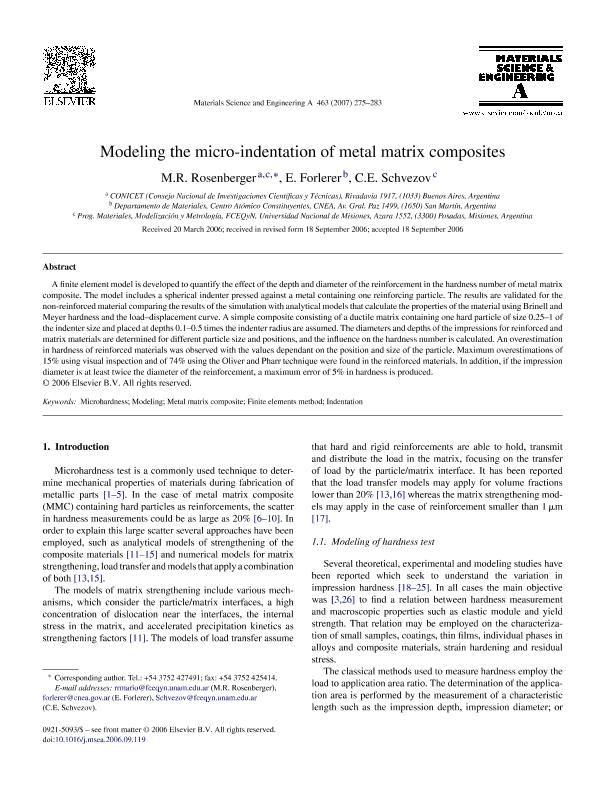Mostrar el registro sencillo del ítem
dc.contributor.author
Rosenberger, Mario Roberto

dc.contributor.author
Forlerer, Elena

dc.contributor.author
Schvezov, Carlos Enrique

dc.date.available
2018-09-14T18:47:58Z
dc.date.issued
2007-08
dc.identifier.citation
Rosenberger, Mario Roberto; Forlerer, Elena; Schvezov, Carlos Enrique; Modeling the micro-indentation of metal matrix composites; Elsevier Science Sa; Materials Science and Engineering A: Structural Materials: Properties, Microstructure and Processing; 463; 1-2; 8-2007; 275-283
dc.identifier.issn
0921-5093
dc.identifier.uri
http://hdl.handle.net/11336/59757
dc.description.abstract
A finite element model is developed to quantify the effect of the depth and diameter of the reinforcement in the hardness number of metal matrix composite. The model includes a spherical indenter pressed against a metal containing one reinforcing particle. The results are validated for the non-reinforced material comparing the results of the simulation with analytical models that calculate the properties of the material using Brinell and Meyer hardness and the load-displacement curve. A simple composite consisting of a ductile matrix containing one hard particle of size 0.25-1 of the indenter size and placed at depths 0.1-0.5 times the indenter radius are assumed. The diameters and depths of the impressions for reinforced and matrix materials are determined for different particle size and positions, and the influence on the hardness number is calculated. An overestimation in hardness of reinforced materials was observed with the values dependant on the position and size of the particle. Maximum overestimations of 15% using visual inspection and of 74% using the Oliver and Pharr technique were found in the reinforced materials. In addition, if the impression diameter is at least twice the diameter of the reinforcement, a maximum error of 5% in hardness is produced. © 2006 Elsevier B.V. All rights reserved.
dc.format
application/pdf
dc.language.iso
eng
dc.publisher
Elsevier Science Sa

dc.rights
info:eu-repo/semantics/openAccess
dc.rights.uri
https://creativecommons.org/licenses/by-nc-sa/2.5/ar/
dc.subject
Finite Elements Method
dc.subject
Indentation
dc.subject
Metal Matrix Composite
dc.subject
Microhardness
dc.subject
Modeling
dc.subject.classification
Ingeniería de los Materiales

dc.subject.classification
Ingeniería de los Materiales

dc.subject.classification
INGENIERÍAS Y TECNOLOGÍAS

dc.title
Modeling the micro-indentation of metal matrix composites
dc.type
info:eu-repo/semantics/article
dc.type
info:ar-repo/semantics/artículo
dc.type
info:eu-repo/semantics/publishedVersion
dc.date.updated
2018-09-12T17:30:21Z
dc.journal.volume
463
dc.journal.number
1-2
dc.journal.pagination
275-283
dc.journal.pais
Países Bajos

dc.journal.ciudad
Amsterdam
dc.description.fil
Fil: Rosenberger, Mario Roberto. Consejo Nacional de Investigaciones Científicas y Técnicas; Argentina. Universidad Nacional de Misiones; Argentina
dc.description.fil
Fil: Forlerer, Elena. Comisión Nacional de Energía Atómica. Centro Atómico Constituyentes; Argentina
dc.description.fil
Fil: Schvezov, Carlos Enrique. Comisión Nacional de Energía Atómica. Centro Atómico Constituyentes; Argentina. Universidad Nacional de Misiones; Argentina
dc.journal.title
Materials Science and Engineering A: Structural Materials: Properties, Microstructure and Processing

dc.relation.alternativeid
info:eu-repo/semantics/altIdentifier/doi/http://dx.doi.org/10.1016/j.msea.2006.09.119
dc.relation.alternativeid
info:eu-repo/semantics/altIdentifier/url/https://www.sciencedirect.com/science/article/pii/S0921509306025639?via%3Dihub
Archivos asociados
